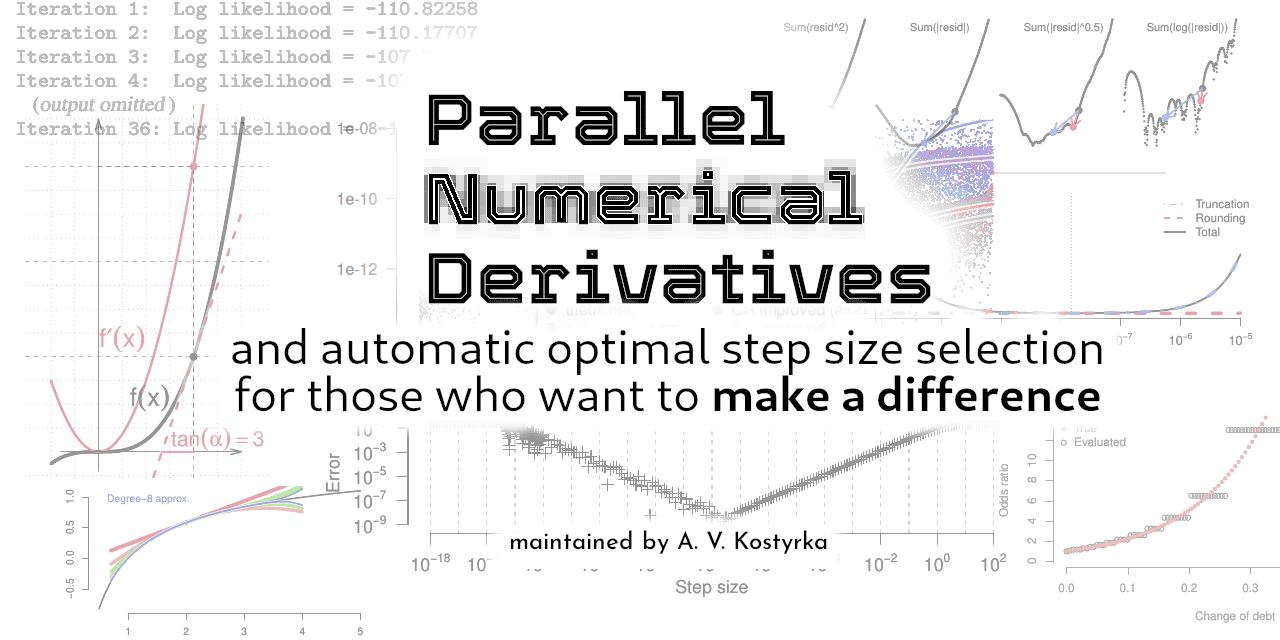An R package for computing fast and accurate numerical derivatives.
In the past, I was using numDeriv to compute numerical gradients. However, the results were not stable for some function, and I could not investigate the source of this instability. Different step sizes yielded different results. Small step sizes were sometimes better, sometimes worse.
The pnd package was designed to offer a comprehensive tool-kit containing popular algorithms for finite differences, numerical gradients, Jacobians, and Hessians.
Optimal step sizes and parallel evaluation of numerical derivatives translate directly to faster numerical optimisation and statistical inference.
- Robust numerical differentiation: effortlessly compute derivatives while controlling the accuracy-speed trade-off.
- Gradient and Hessian calculations: obtain the direction and curvature required by most quasi-Newton optimisation algorithms.
- Parallel capabilities: evaluate multiple values under the best parallelisation scheme that reduces overhead. For example, on a 12-core machine, a 4th-order accurate Jacobian of a 3-dimensional function takes almost the same amount of time as one function evaluation.
- Optimal step size selection: obtain adaptive step size to ensure the best trade-off between mathematical truncation error and computer floating-point rounding error for the best overall accuracy.
- Four optimal step selection algorithms: choose between Curtis–Reid (1974) and its modern (2024) modification, Dumontet–Vignes (1977), and Stepleman–Winarsky (1979) algorithms. Future versions will feature parallelised algorithms.
This package has numDeriv-compatible syntax.
Simply replace the first letter of numDeriv commands with a capital one to get the improved commands: Grad, Jacobian, and Hessian.
Here is how to compute the gradient of f(x) = sum(sin(x)) at the point x = (1, 2, 3, 4).
f <- function(x) sum(sin(x))
x <- 1:4
names(x) <- c("Jan", "Feb", "Mar", "Apr")
numDeriv::grad(f, x)
#> 0.5403023 -0.4161468 -0.9899925 -0.6536436
pnd::Grad(f, x)
#> Jan Feb Mar Apr
#> 0.5403023 -0.4161468 -0.9899925 -0.6536436
#> attr(,"step.size")
#> Jan Feb Mar Apr
#> 6.055454e-06 1.211091e-05 1.816636e-05 2.422182e-05
#> attr(,"step.size.method")
#> "default"The output contains diagnostic information about the chosen step size. Our function
preserved the names of the input argument, unlike grad.
The default step size in many implementations is proportional to the argument value, and this is reflected in the default output.
Should the user desire a fixed step size, this can be easily achieved with an extra argument named h:
pnd::Grad(f, x, h = c(1e-5, 1e-5, 1e-5, 2e-5))
#> Jan Feb Mar Apr
#> 0.5403023 -0.4161468 -0.9899925 -0.6536436
#> attr(,"step.size")
#> Jan Feb Mar Apr
#> 1e-05 1e-05 1e-05 2e-05
attr(,"step.size.method")
#> "user-supplied"Finally, it is easy to request an algorithmically chosen optimal step size -- here is how to do it with the Stepleman--Winarsky (1979) rule, named "SW", that works well in practice:
pnd::Grad(f, x, h = "SW")
#> Jan Feb Mar Apr
#> 0.5403023 -0.4161468 -0.9899925 -0.6536436
#> attr(,"step.size")
#> Jan Feb Mar Apr
#> 5.048535e-06 1.000000e-05 7.500000e-06 1.000000e-05
#> attr(,"step.size.method")
#> "SW"Extensive diagnostics and error estimates can be requested at any time:
pnd::Grad(f, x, h = "SW", report = 2) will contain the step-search path for each coordinate of x. Use report = 0 to produce just the numerical gradient without any attributes, like numDeriv::grad would.
- PDF of an early 2024 presentation at the University of Luxembourg. (Some functions might be outdated – check the package vignette for up-to-date examples!)
This package is supported by a vignette:
- Kostyrka, A. V. Using parallel numerical derivatives for fast optimisation and reliable inference in R. In progress.
The following articles provide the theory behind the methods implemented in this package:
- Kostyrka, A. V. (2024). What are you doing, step size: fast computation of accurate numerical derivatives with finite precision. In progress.
This package currently exists only on GitHub. To install it, run the following two commands:
install.packages("devtools")
devtools::install_github("Fifis/pnd")To load this package, include this line in the code:
library(pnd)This package is almost dependency-free; the parallel library belongs to the base
group and is included in most R distributions.
This software is released under the free/open-source EUPL 1.2 licence.

